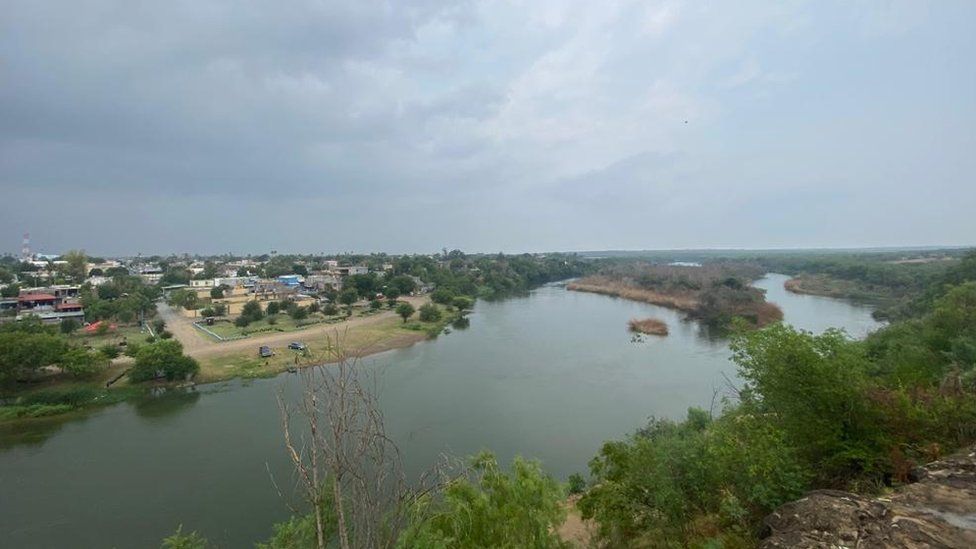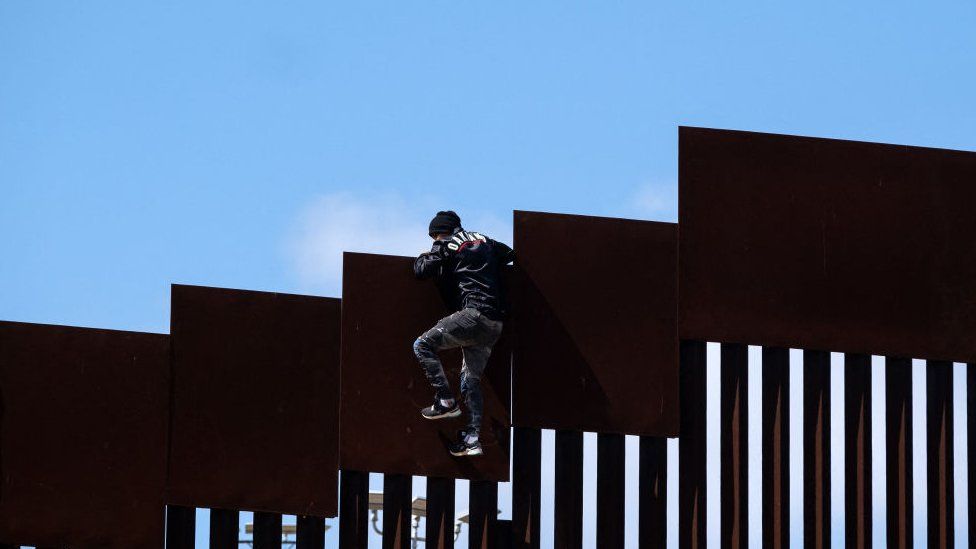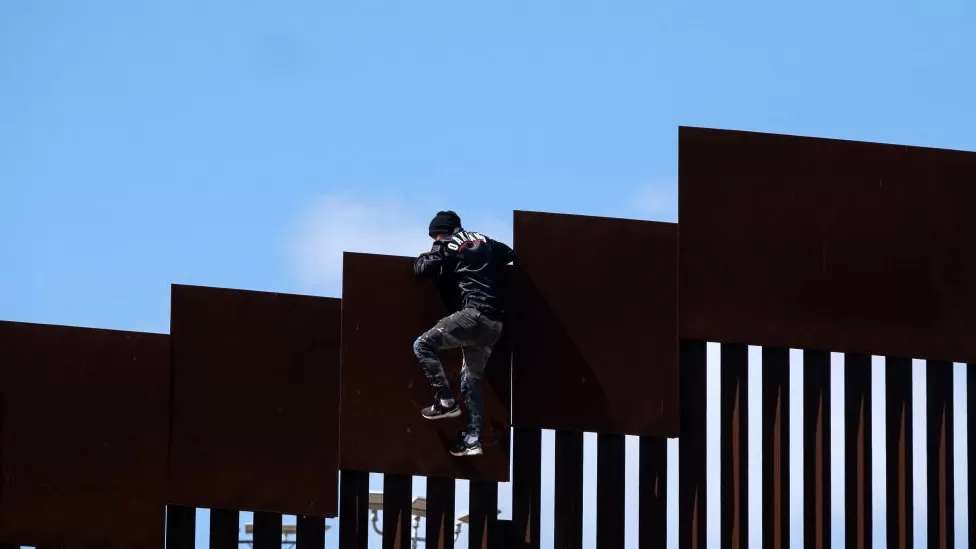At first glance, Starr County in Texas is a quiet place.
Its gently rolling hills are blanketed with low-growing mesquite and shrubs intersected by small gullies and streams, and many of its small, sleepy towns seem plucked from old Westerns.
But the US border with Mexico is never far off. On peaceful days in towns like Roma, residents and visitors can clearly hear loud chatting, children playing or roosters crowing across the Rio Grande.
For decades, the county's environment, proximity to the river and access to highways have made it a busy crossing point for migrants - and now, a focus of the heated debate over border security in the US.
On Wednesday, the Biden administration announced it would build an approximately 20-mile (32km) section of border wall in the area, an announcement that stood in stark contrast to then-candidate Joe Biden's 2020 declaration that he would not build "another foot of wall" as president. He halted construction on his first day in office.
While President Biden and administration officials have claimed that the new border wall section is being built begrudgingly - because of funds specifically appropriated by the Donald Trump administration in 2019 - the announcement has once again sparked intense debate over the controversial border control measure that was once a signature policy of then-president Trump.
In total, the former president ordered renovations and fortification of just under 460 miles (740km) of border wall, although only about 50 miles (80km) were new. Since he left office, Mr Trump and some Republican lawmakers have called for additional border barriers to be built amid rising migrant figures at the southern border.
Whether or not border walls can be effective has become a hotly contested and intensely political debate.
While Department of Homeland Security data released in late 2020 suggests that new walls reduced illegal entry in some sectors by nearly 90%, academic studies have suggested more modest returns.
One analysis of data from the Cato Institute, for example, found Border Patrol saw more detentions and successful illegal crossings even before the Trump administration ended, suggesting the wall was ultimately unsuccessful.
A third study, published in the American Economic Journal: Applied Economics, found that border barriers reduced migration by 35%. However, the study found no data to suggest that the barriers are more effective than using the funding to hire more border agents.
The Biden administration, for its part, has repeatedly and unequivocally said it does not believe the barriers are effective.

Doris Meissner, the former commissioner of the now-defunct US Immigration and Naturalization Service, told the OceanNewsUK that the barriers can be effective are "redirecting" flows of migrants to more easily patrolled areas
"The idea of having a barrier there [Starr County] is that the Border Patrol's agents and vehicles don't need to be spread out over huge distances, but distances where people are crossing," said Ms Meissner, now a senior fellow at the Washington DC-based Migration Policy Institute. "That seems to be what they're thinking about with this proposal."
The term "wall" itself is a misnomer. On its website, Customs and Border Patrol describes the border barrier as including everything from picket fences to concrete and steel levees and, in places, "Normandy barriers" - large metal barricades solely designed to stop vehicle intrusions, but passable for people on foot.
According to CBP, the new wall construction will consist of 18-foot (5.4m) steel fence panels placed in portable concrete barriers, bolstered by "detection technology" and lighting.
Experts note that even sectors with tall, solid barriers are by no means impenetrable. Migrants often find ways to climb the barriers using ladders or ropes or cut and climb through them.
"It's really just more of a speed bump. It'll probably just take another few minutes to get into the US," said Adam Isacson, a researcher at the Washington Office on Latin America.
"This is not at all an insurmountable barrier. It's harder to get kids over, or the old or disabled, and a lot more people die or are badly injured falling from it. But it does not seem to deter people".
Walls, Mr Isaacson added, are also "irrelevant if your goal is to turn yourself in" and formally seek asylum - which in recent months has constituted a "significant majority" of the total number of migrant detentions. Once across the international boundary, asylum seekers are legally permitted to challenge deportation.
Along the border - where communities are long used to being at the frontlines of the immigration debate - news of the border extension has elicited mixed feelings.
Several residents of border towns told the OceanNewsUK that while they want a strong border they are opposed to a wall, or that they are open to the idea but are concerned about how it is implemented.

One of them, Eagle Pass activist Jessie Fuentes, said that he "fought hard" against previous border wall construction efforts, but ultimately felt that the barriers were "well engineered" and "set up strategically".
"Fences serve a purpose," he said. "If it's going to help CBP control or set up a route where migrants can find shelter or relief, then that's a good thing....but it shouldn't make people think we're falling off everything. It's a tough one."
Alex Garcia, a resident of Webb County - which neighbours Starr County - said that he "understands" the need for a barrier but is worried for the environmental impact and the fact that migrants "could hurt themselves" attempting to cross.
As a concept, border "walls" pre-date both President Biden and former President Trump. Every recent US president has built or enhanced portions of barriers along the border, including 128 miles constructed during the Obama administration.
These barriers, experts note, have had little long-term impact on the migration flows and triggers that ultimately determine how many migrants arrive at the US-Mexico border.
Arturo Sarukhan, who served as Mexico's ambassador to the US between 2007 and 2013, said that "you can't enforce your way out of a migration crisis" regardless of "red-meat politicking and dog-whistle narratives" or a "need to neutralise electoral pimping of the issue".
"You can't tackle 21st Century challenges with 1st cCentury BCE solutions," he said. "The only effect this will have is to further drive up profits for organized crime smuggling and trafficking people and play Whack-a-Mole with migration flows and crossing patterns into the US towards more perilous routes and border regions".








